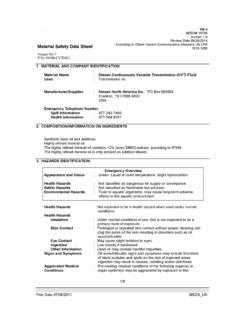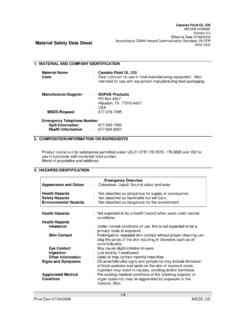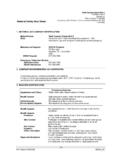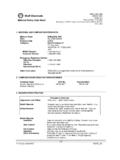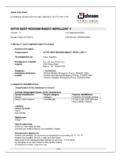Transcription of Effective Date 07/03/2008 Material Safety Data …
1 AeroShell Grease 33 MSMSDS# 402828L Version Effective Date 07/02/2008 Material Safety Data Sheet according to osha Hazard communication Standard, 29 CFR 1/8 Print Date 10/10/2008 MSDS_US 1. Material AND COMPANY IDENTIFICATION Material Name : AeroShell Grease 33 MS Uses : Synthetic grease for aircraft, containing molybdenum disulphide. For further details consult the AeroShell Book on Manufacturer/Supplier : SOPUS Products PO BOX 4427 Houston, TX 77210-4427 USA MSDS Request : 877-276-7285 Emergency Telephone Number Spill Information : 877-242-7400 Health Information : 877-504-9351 2. COMPOSITION/INFORMATION ON INGREDIENTS Chemical Identity CAS No. Concentration Molybdenum disulphide 1317-33-5 - % A lubricating grease consisting of highly-refined mineral oil and additives. 3. hazards IDENTIFICATION Emergency Overview Appearance and Odour : Dark grey. Semi-solid at ambient temperature. Slight hydrocarbon. Health hazards : High-pressure injection under the skin may cause serious damage including local necrosis.
2 Safety hazards : Not classified as flammable but will burn. Environmental hazards : Not classified as dangerous for the environment. Health hazards : Not expected to be a health hazard when used under normal conditions. Health hazards Inhalation : Under normal conditions of use, this is not expected to be a primary route of exposure. Skin Contact : Prolonged or repeated skin contact without proper cleaning can clog the pores of the skin resulting in disorders such as oil acne/folliculitis. Eye Contact : May cause slight irritation to eyes. Ingestion : Low toxicity if swallowed. Other Information : High-pressure injection under the skin may cause serious damage including local necrosis. Used grease may contain harmful impurities. Signs and Symptoms : Local necrosis is evidenced by delayed onset of pain and tissue AeroShell Grease 33 MSMSDS# 402828L Version Effective Date 07/02/2008 Material Safety Data Sheet according to osha Hazard communication Standard, 29 CFR 2/8 Print Date 10/10/2008 MSDS_US damage a few hours following injection.
3 Oil acne/folliculitis signs and symptoms may include formation of black pustules and spots on the skin of exposed areas. Ingestion may result in nausea, vomiting and/or diarrhoea. Aggravated Medical Condition : Pre-existing medical conditions of the following organ(s) or organ system(s) may be aggravated by exposure to this Material : Skin. Environmental hazards : Not classified as dangerous for the environment. Additional Information : Under normal conditions of use or in a foreseeable emergency, this product does not meet the definition of a hazardous chemical when evaluated according to the osha Hazard communication Standard, 29 CFR 4. FIRST AID MEASURES General Information : Not expected to be a health hazard when used under normal conditions. Inhalation : No treatment necessary under normal conditions of use. If symptoms persist, obtain medical advice. Skin Contact : Remove contaminated clothing. Flush exposed area with water and follow by washing with soap if available.
4 When using high pressure equipment, injection of product under the skin can occur. If high pressure injuries occur, the casualty should be sent immediately to a hospital. Do not wait for symptoms to develop. If persistent irritation occurs, obtain medical attention. Obtain medical attention even in the absence of apparent wounds. Eye Contact : Flush eye with copious quantities of water. If persistent irritation occurs, obtain medical attention. Ingestion : In general no treatment is necessary unless large quantities are swallowed, however, get medical advice. Advice to Physician : Treat symptomatically. High pressure injection injuries require prompt surgical intervention and possibly steroid therapy, to minimise tissue damage and loss of function. Because entry wounds are small and do not reflect the seriousness of the underlying damage, surgical exploration to determine the extent of involvement may be necessary. Local anaesthetics or hot soaks should be avoided because they can contribute to swelling, vasospasm and ischaemia.
5 Prompt surgical decompression, debridement and evacuation of foreign Material should be performed under general anaesthetics, and wide exploration is essential. 5. FIRE FIGHTING MEASURES Clear fire area of all non-emergency personnel. Flash point : > 215 C / 419 F (PMCC / ASTM D93) Upper / lower Flammability or Explosion limits : Typical 1 - 10 %(V) Auto ignition temperature : > 320 C / 608 F AeroShell Grease 33 MSMSDS# 402828L Version Effective Date 07/02/2008 Material Safety Data Sheet according to osha Hazard communication Standard, 29 CFR 3/8 Print Date 10/10/2008 MSDS_US Specific hazards : Hazardous combustion products may include: A complex mixture of airborne solid and liquid particulates and gases (smoke). Carbon monoxide. Unidentified organic and inorganic compounds. Suitable Extinguishing Media : Foam, water spray or fog. Dry chemical powder, carbon dioxide, sand or earth may be used for small fires only. Unsuitable Extinguishing Media : Do not use water in a jet.
6 Protective Equipment for Firefighters : Proper protective equipment including breathing apparatus must be worn when approaching a fire in a confined space. 6. ACCIDENTAL RELEASE MEASURES Avoid contact with spilled or released Material . For guidance on selection of personal protective equipment see Chapter 8 of this Material Safety Data Sheet. See Chapter 13 for information on disposal. Protective measures : Avoid contact with skin and eyes. Use appropriate containment to avoid environmental contamination. Prevent from spreading or entering drains, ditches or rivers by using sand, earth, or other appropriate barriers. Clean Up Methods : Shovel into a suitable clearly marked container for disposal or reclamation in accordance with local regulations. 7. HANDLING AND STORAGE General Precautions : Use local exhaust ventilation if there is risk of inhalation of vapours, mists or aerosols. Properly dispose of any contaminated rags or cleaning materials in order to prevent fires.
7 Use the information in this data sheet as input to a risk assessment of local circumstances to help determine appropriate controls for safe handling, storage and disposal of this Material . Handling : Avoid prolonged or repeated contact with skin. Avoid inhaling vapour and/or mists. When handling product in drums, Safety footwear should be worn and proper handling equipment should be used. Storage : Keep container tightly closed and in a cool, well-ventilated place. Use properly labelled and closeable containers. Storage Temperature: -50 - 50 C / -58 - 122 F Recommended Materials : For containers or container linings, use mild steel or high density polyethylene. Unsuitable Materials : PVC. Additional Information : Polyethylene containers should not be exposed to high temperatures because of possible risk of distortion. 8. EXPOSURE CONTROLS/PERSONAL PROTECTION Occupational Exposure Limits Material Source Type ppm mg/m3 Notation AeroShell Grease 33 MSMSDS# 402828L Version Effective Date 07/02/2008 Material Safety Data Sheet according to osha Hazard communication Standard, 29 CFR 4/8 Print Date 10/10/2008 MSDS_US Molybdenum disulphide ACGIH TWA(Respirable fraction.)
8 Mg/m3 as Mo Molybdenum disulphide osha Z1 PEL 5 mg/m3 as Mo Molybdenum disulphide osha Z1A TWA 5 mg/m3 as Mo Molybdenum disulphide ACGIH TWA(Inhalable fraction.) 10 mg/m3 as Mo Molybdenum disulphide ACGIH TWA(Respirable fraction.) 3 mg/m3 as Mo Molybdenum disulphide osha Z1 PEL(Total dust.) 15 mg/m3 as Mo Molybdenum disulphide osha Z1A TWA(Total dust.) 10 mg/m3 as Mo Additional Information : Due to the product's semi-solid consistency, generation of mists and dusts is unlikely to occur. Exposure Controls : The level of protection and types of controls necessary will vary depending upon potential exposure conditions. Select controls based on a risk assessment of local circumstances. Appropriate measures include: Adequate ventilation to control airborne concentrations. Where Material is heated, sprayed or mist formed, there is greater potential for airborne concentrations to be generated. Personal Protective Equipment : Personal protective equipment (PPE) should meet recommended national standards .
9 Check with PPE suppliers. Respiratory Protection : No respiratory protection is ordinarily required under normal conditions of use. In accordance with good industrial hygiene practices, precautions should be taken to avoid breathing of Material . If engineering controls do not maintain airborne concentrations to a level which is adequate to protect worker health, select respiratory protection equipment suitable for the specific conditions of use and meeting relevant legislation. Check with respiratory protective equipment suppliers. Where air-filtering respirators are suitable, select an appropriate combination of mask and filter. Select a filter suitable for combined particulate/organic gases and vapours [boiling point >65 C (149 F)]. Hand Protection : Where hand contact with the product may occur the use of gloves approved to relevant standards ( Europe: EN374, US: F739) made from the following materials may provide suitable chemical protection: PVC, neoprene or nitrile rubber gloves.
10 Suitability and durability of a glove is dependent on AeroShell Grease 33 MSMSDS# 402828L Version Effective Date 07/02/2008 Material Safety Data Sheet according to osha Hazard communication Standard, 29 CFR 5/8 Print Date 10/10/2008 MSDS_US usage, frequency and duration of contact, chemical resistance of glove Material , glove thickness, dexterity. Always seek advice from glove suppliers. Contaminated gloves should be replaced. Personal hygiene is a key element of Effective hand care. Gloves must only be worn on clean hands. After using gloves, hands should be washed and dried thoroughly. Application of a non-perfumed moisturizer is recommended. Eye Protection : Wear Safety glasses or full face shield if splashes are likely to occur. Protective Clothing : Skin protection not ordinarily required beyond standard issue work clothes. Monitoring Methods : Monitoring of the concentration of substances in the breathing zone of workers or in the general workplace may be required to confirm compliance with an OEL and adequacy of exposure controls.
